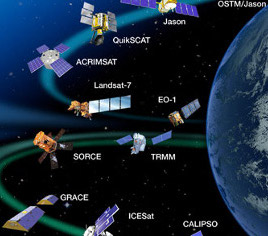 |
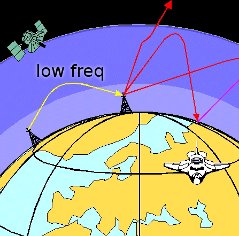 |
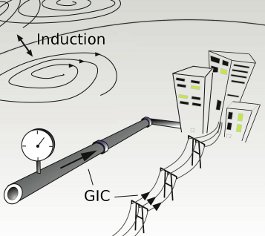 |
| Earth satellite sample by NASA | Ionospheric radio reflection by GSFC | Geomagnetic induced currents by Wikipedia |
Space weather are solar and cosmic background effects on satellites and astronauts, the ionosphere, and ground systems. Our solar system is not quite as empty as the word "space" implies: Photons, electrons and protons (plus ions) from the Sun fill most of the solar system (the heliosphere), driving back the galactic cosmic rays (GCR) coming from other places in the galaxy.
In this article, I try to explain the basics of space weather suited to the understanding of computer scientists, as I have struggled quite a bit with solar physics concepts since 2004, when I started working for SWENET (ESA's space weather european network), which in 2015 became a part of SSA (ESA's space situational awareness programme). If you are the next CS guy to get into space weather, maybe this text can help you!
Disclaimer: I use a lot of terms very loosely, do not mention some important concepts, and shun relativity and quantum effects completely, all for the sake of simplicity. If you are a physicist, be lenient. Please.
For thousands of years, interest in space weather has been rather marginal. Only in the last few hundred years it has become relevant: We began relying on compasses (which depend on earth's magnetic field), started building long conductors (telegraphs, power lines, pipelines, rails: all susceptible to electrical induction), discovered long distance radio (signal reflected by ionosphere) and ultimately brought satellites into space (radiation sensitive microelectronics).
 |
 |
 |
| Earth satellite sample by NASA | Ionospheric radio reflection by GSFC | Geomagnetic induced currents by Wikipedia |
All these systems were, at first, built without space weather in mind. Our sun always shines, quietly emitting light (photons) and material (electrons, protons) onto earth's dayside in a steady flow. Effects on technological systems are minor, unless there is noticable variation in this flow. Small and medium variations occur all the time; the rarest and biggest variation is the coronal mass ejection + solar flare.
On the left picture you see a coronal mass ejection (CME) pointing upwards; although not very dense, it extends to a size easily as large as the sun itself. The right picture shows solar flares, which accompany every eruption (including CMEs) and consist of increased amounts of photons. On both images, the firing direction is conveniently mostly away from us, but sometimes we are not as lucky: If it points towards us, we have a solar event. And that is why we are interested in space weather.
Space weather is foremost what comes from the sun -- lots of photons (="EM radiation") and charged particles (electrons and protons, plus ions). But the emissions are not smooth: In an 11 year cycle, the sun gets quiet and excited ("active") again, with wild flares at its peak and a steady flow at its low.
After being emitted from the sun's surface, photons and particles have to travel to earth. In a total void, that would be a very straight line of travel (and for photons, it is). For particles, which have electric charge, not quite so: Because the sun, like the earth, has a magnetic field. And, to complicate things, the field is not perfectly smooth either (especially in active times).
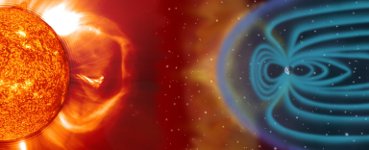 |
| Space weather illustration by NASA Images |
A part of the emissions hit earth's magnetic field. Again, photons are unimpressed. Particles have to oblige the Lorentz force according to their charge: Protons and cations go to the right, electrons and anions to the left. They add to the other particles that are already present in the so-called radiation belts.
So here starts the problem: That is more or less where most of our satellites are. Of course they have some shielding, and in most cases that is enough. But when a real strong "wave" (coronal mass ejection or solar flare) hits, it is best to turn the thing off for a while to avoid erratic electrical effects.
And it goes further down. The first major atmospheric layer to be hit is the ionosphere, which is pretty important because all non-line-of-sight radio communications reflect off it (plus, it is between us and the GPS satellites). Here, the photons are stopped or scattered for the first time, and some of the particles hit atmospheric molecules too. In active times, while the ionosphere fluctuates wildly, we have bad or no radio signal connections.
And it goes even further down. With the earth's magnetic field also contorting due to the onslaught, the Lorentz force works on all electrons/protons/ions in long conductors. And we have a few: Power lines (think "burned out transformator stations"), pipelines (relatively harmless in the short term: increased corrosion) and rail lines (even more harmless: safety equipment will trigger erratically).
And that would be it. If you have understood everything above clearly, please leave now. Otherwise, follow me as we work all this through in a little more detail...
Before we start, we have to get some basic physics in order: Light (photons), and electromagnetic effects on electrons/protons.
First, light: Photons are radiation are light. No mass, light speed (300.000 km/s, taking 8 minutes for the 150.000.000 km (1 AU) that the sun is away from us). They carry an electromagnetic field field with them, but the field strength is very small. Photons have wavelengths from femtameter (10-15m) to gigameter (109m) (see SI units).
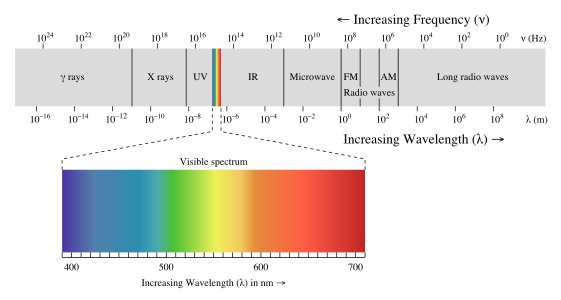 |
| Electromagnetic (EM) spectrum by Wikipedia |
Although photons have no mass, they do have impact energy! The shorter wavelengths are more powerful (e.g. radioactive gamma rays), the longer are relatively harmless (e.g. long radio waves). Visible light is somewhere in between (sunburn, but not immediate death).
Every wavelength has a corresponding frequency that cannot be changed. You can only throw more photons at something, but not faster (always speed of light) or with bigger amplitude (that concept is not applicable for light, ask the quantum guys why).
Second, particles: Electrons have a negative charge, protons a positive charge. A proton is in the order of 1000x bigger than an electron (i.e. more powerful on impact). Atoms are neutral; as ions (one electron added (anion, -) or removed (cation, +)), they are charged. Ions are often created when short-wavelength (powerful) photons knock off electrons in an atom.
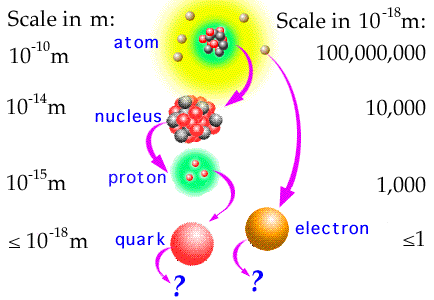 |
| Particles scale by NASA/GSFC Section 20 |
All moving charged particles create an electromagnetic field (electric and magnetic fields are actually the same effect). The right-hand grip rule gives you the direction: Anything (e.g. a proton) moving towards a negative pole follows your right hand's thumb, and if you torque to the right, that is the (circular) direction of the EM field.
Due to that EM field, other EM fields (such as the one around earth) can influence the direction of a moving particle. The Lorentz force changes the vector of an electron or proton according to the right-hand rule (not to be confused with the right-hand grip rule above).
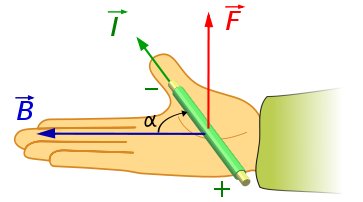 |
| Right hand rule for EM fields by Wikipedia |
In the figure above, B is earth's magnetic field (should point upward, not left), I is the moving proton (moves to the negative pole), and F is the force due to the magnetic field. So tilt your head to the left and think: If a proton flies into the earth, and encounters a magnetic field that points up, then the proton is steered to the right. Likewise, an electron is steered to the left.
And that should be it for our little refresher in physics.
So, back to the fun part! The sun emits photons and particles all day long, while it rotates (27 days for one rotation). But the sun does not rotate like a solid ball of steel -- it is made of gas, which is far less cohesive, and so the 27 days are actually an average: A rotation takes 24 days on the equator and 35 days near the poles. You can imagine that this sort of "perpetual tectonic twisting" contorts the sun's magnetic field quite a bit.
 |
| Sunspot formation through magnetic field twisting by UCAR |
All the mass (particles) of the sun is charged, and is influenced by these magnetic field lines. This is where sunspots (either deep wells or concentrated areas of mass) come from. Lots of electrons, protons and photons live around there, and when one of these magnetic bubbles (or arcs, or filaments, or other strange structure) bursts, then we got alarm: A reconnecting magnetic field collapses super quickly, and accelerates all particles around it.
We have two kinds of eruptions to be aware of: Coronal mass ejections (CME) and solar flares. CMEs are massive amounts of electrons and protons, which have quite an impact on anything they meet, but they are comparatively slow (need 2-3 days to reach earth). Solar flares are massive amounts of photons of all wavelengths, but most pronounced in the extreme ultra-violet (EUV) range (λ=10-8m), which pack a pretty punch due to their short wavelength.
We know all this because we (or rather: space agencies like NASA, ESA, and JAXA) have satellites that watch the sun: SOHO (1995), ACE (1997), TRACE (1998), Hinode (2006), STEREO (2006). And a lot of earth-orbiting satellites also monitor the photons, electrons and protons flying by as well as the magnetic field strength: GOES series (1975+), RHESSI (2002), and probably even more that I am not aware of.
In the figures above, you see the sun, but in the xray spectrum instead of visible light: This is because the differences between quiet and active areas on the surface can be seen much better in the shorter wavelengths.
Having satellites is way better than what we did before: Watch the sun through a telescope. The resolution was bad, the atmosphere was in the way and most of the xray and UV (λ<=10-7m) photons were filtered out anyway. But, sunspots could be counted, and that was a beginning. By the way (shameless plug), my project SWENET had, until 2015, monthly SSN (sunspot numbers, now at SILS) from the SIDC (Belgium) and BINCASTS (Britain) services.
Monthly sunspot counts were recorded since 1750; the figure above shows the last 80 years. From counting the sunspot numbers, it follows pretty quickly that the typical solar cycle takes 11 years. Right now, in 2010 we are at the end of an "all quiet" period, so now is the time to get some new satellites started (Themis and SDO, I am looking at you).
And that is the short course on the sun: Emits photons, electrons and protons all the time; produces hefty coronal mass ejections (CME) and solar flares when magnetic field locally contorted; and follows an 11-year activity cycle.
In interplanetary space, there are mainly two things, both originating from the sun: The steady solar wind (the photons and particles) and the magnetic field of the sun. Additionally, particles from outside the heliosphere (called galactic cosmic rays) blast in, but they are relatively few (103 vs. 1012 particles m-2s-2).
There is one more thing: All the particles from the sun carry a magnetic field too. Since the particles go steadily in all directions, this is a major effect, called interplanetary magnetic field (IMF). The sun rotates, and so we get the funny structure called a Parker spiral shown in the figure below.
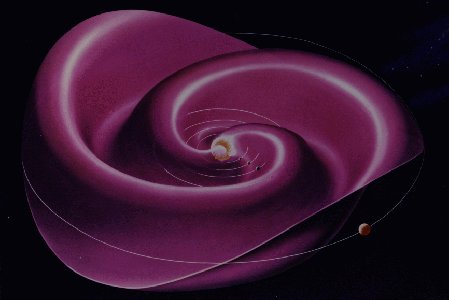 |
| Interplanetary magnetic field (a Parker spiral) by Wikipedia |
The figure above shows a parker spiral with the sun at the center and orbiting planets around. Each "high" of the spiral is caused by a sunspot that emits heightened amounts of particles and photons. As one portion of the stream travels through space, the next one is emitted with the sun already turned a bit further.
And so the bottom line for interplanetary space is: Full of photons and particles, and shaped by complex magnetic fields.
We covered the emission and the travel. Now photons and particles arrive at earth's magnetosphere (magnetic field). Good news: Photons pass right through. Bad news: Particles are in for quite a ride. First we look what happens to the magnetosphere, then we look after the particles.
The magnetic field decelerates the particles rapidly. So rapidly, in fact, that there is a supersonic boom known as the bow shock at the front of the earth. This shock energy has to go somewhere, and it does: The field flattens at the front, and the shock wave propagates through the magnetic field to the back side of the earth, where it forms the magnetotail.
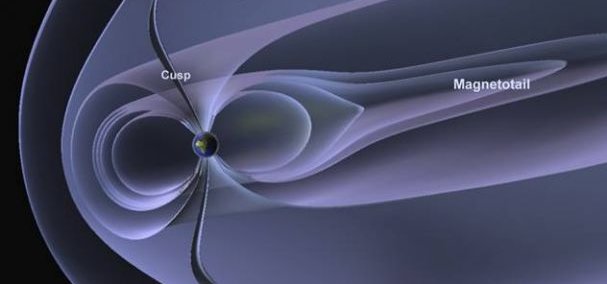 |
| Earth's magnetosphere by INGV |
The figure above shows the flattened front and the elongated back of the magnetosphere. You can also see that earth's north and south pole are largely unprotected; that is why you see auroras there. As another shameless plug, SWENET has aurora indicators from the AurorasNow (Finland) service.
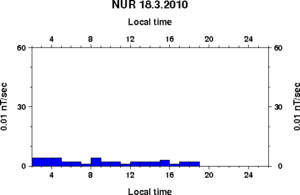 |
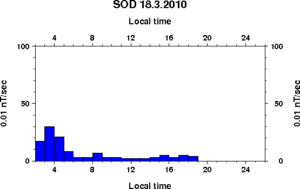 |
| Aurora indicators from two stations by AurorasNow via SWENET | |
The plots above show magnetic field changes from the 2 stations in Finland (Nurmijarvi and Sodankyla). The more rapid the field change (in horizontal direction), the more likely that there was a massive hit upon the magnetosphere. As you can see, in March 2010 there is not much activity.
Back into space. Following the Lorentz force, the magnetic field steers protons to the right and electrons to the left (ions according to charge). Depending on their initial speed, particles are either unimpressed or deflected. Naturally, CMEs are more likely to be unimpressed than the normal solar wind. But even on standard conditions, a small portion of the particles (mostly electrons) go straight through into the magnetotail. And there, the strongly compressed magnetic field has a curious effect: Magnetic reconnection gives the particles a push back to earth.
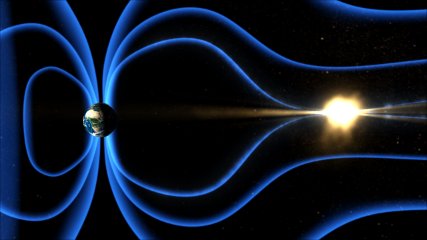 |
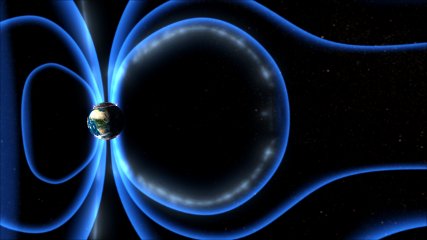 |
| Magnetotail reconnection and electron backflow by GSFC | |
In the figure above, you see how particles inside the magnetotail bounce back after a magnetic reconnection, flying into the north and south pole to cause auroras. Some of the particles also bounce back into an orbit around the earth; they become part of the so-called radiation belts. But solar wind particles are not the only ones orbiting earth. Hit by short-wavelength photons, a part of the particles in the ionosphere (see next section) gets heated to plasma state, goes up into space, and also becomes trapped in the belts.
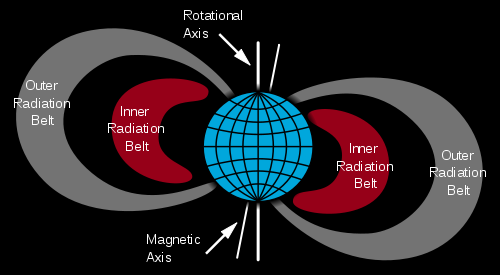 |
| Radiation belts by Wikipedia |
The figure above shows that there are two especially particle-rich orbits: The outer radiation belt shelters primarily electrons from the solar wind (with typical energies around 1 MeV), while the inner belt features both electrons (~ 0.1 MeV) and protons (~ 100 MeV) coming mostly from the ionosphere. It is noteworthy that the belt particles are distinctly different from the solar particles: They flow into the opposite direction (protons to the left, electrons to the right; the Lorentz force pointing earthwards to compensate for the centrifugal force), creating the so-called ring current along the way.
And so this is where both solar and ionospheric particles hit our satellites. Funny effects ensue: Bit flips in computers, big differences in electrical potential e.g. between solar panel and main body (and the resulting sudden lightning), or plain overloading. Remember: In space, there is no ground where all the superfluous electrons or protons could go. Luckily, most electric components have some sort of radiation hardening (see fotos below).
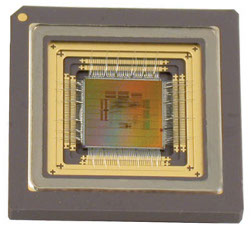 |
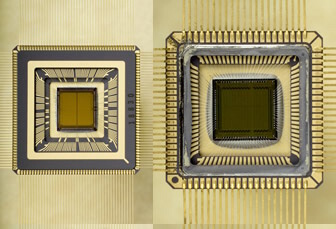 |
| Rad hard SPARC processor by Atmel | Rad hard FPGAs by Bae Systems |
One of the most curious moments is actually when a CME has just passed through. The magnetotail has become quite long from the pressure, and suddenly the CME ends. The magnetic field snaps back. All the particles (especially the electrons, because they are lighter) get a major speed boost that will not play nicely even with rad-hardened equipment. ESA scientists from the Cluster mission even have them dubbed "killer electrons".
To make matters worse, the above mentioned ring current of the radiation belt also has a magnetic field (and a quite powerful one). Using the right-hand grip rule rule again, we arrive at a magnetic field that is opposite that of earth on the inside, and so further weakens it there. But more on that in the "Ground Effects" section later (look out for a Dst index).
For now, that would be the magnetosphere: Deflects electrons, protons and ions in charge-dependent directions; contains radiation belts with ring currents in the opposite direction; ignores photons; and flattens and elongates according to the solar wind pressure (very much so during CMEs).
All photons and the remaining solar particles now hit the ionosphere, the uppermost stage of earth's atmosphere. Particles are so large that they are guaranteed to hit molecules, and are thereby stopped. Photons are scattered, refracted and absorbed, knocking on a lot of molecules in the process. As one of the good effects, most of the xray and UV photons are stopped, so we can actually live on earth.
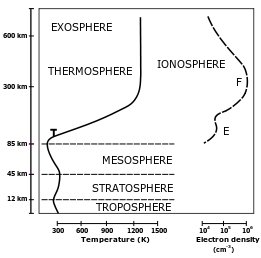 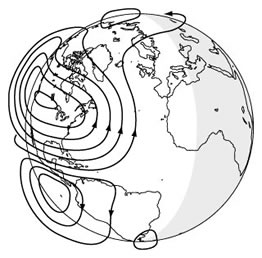 |
| Ionospheric temperatures and electrical currents by Wikipedia |
In the left figure above, you see that the temperatures in the ionosphere (100 to 1000+ km altitude) are higher than elsewhere, meaning that they get hit by more photons than lower atmospheric layers. As circumstantial information (just to remember that we are in earth's atmosphere), you see on the right figure that the electric currents in the ionosphere flow like wind (Coriolis effect).
The short-wavelength photons (xray and UV) are strong enough to kick electrons from atmospheric molecules, and thus the ionosphere is mostly made of ions (hence the name ionosphere). When the kicked electrons descend to where there are more molecules, they recombine with other ions again. And during active times (e.g. during a solar flare), this kick/recombine process is wilder than normal.
Therefore, a good indicator of the ionospheric activity are maps of electron concentrations, also called total electron contents or TEC maps. For the most part, they are made by measuring the GPS signal disturbances, as GPS satellite locations are pretty well known. And incidentally, SWENET has TEC maps from the SWACI (Germany) service.
Unsurprisingly, you see that around the equator, more photons arrive than further north (where more atmosphere stands in the way), and the amount of kick/recombine processes is greater there. Also unsurprisingly, on the backside of the earth ("night") relatively little is happening. The dots on the maps are GPS ground reference stations -- only with these, you can compare the GPS satellite signal to the signal that it should have sent.
And that is the ionosphere: Lots of kicked/recombined electrons; absorbs xray and UV photons; disturbs radio signals of all kinds when agitated.
Finally, we hit the ground. Almost no particles reach here (unless you live at the poles), and the photons that arrive are mostly harmless. What remains? The magnetosphere. When magnetic field lines fluctuate wildly in space, they have to fluctuate down here too, and that leads to a major effect: Geomagnetically induced currents.
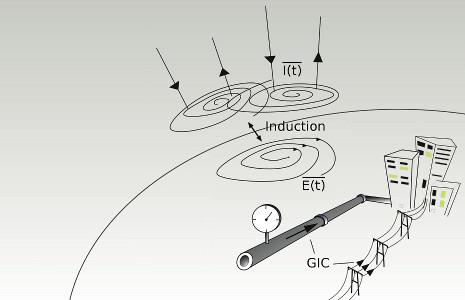 |
| Geomagnetically induced currents by Wikipedia |
Compare the image above to the "electrical currents on globe" figure in the "Ionosphere" chapter. The same magnetic field that led the particles there is also active on ground level, and moves electrons through any conductor (via induction): Power lines, pipelines, rails. The effects are burned-out transformators, increased corrosion and leaks in high-pressure gas pipelines, and erratic train safety equipment spikes.
Of those three effects, only the power lines can be protected: Whenever a solar storm is coming, the lines are simply taken offline. Prediction is mostly based on measurements of earth's magnetic field (similar to aurora prediction). A good indicator is the Disturbance Storm Time (Dst) index, which measures the magnetic field strength difference to quiet times. As fortune wills, SWENET has Dst predictions from the GIFINT (Italy) service.
In the figure above, you see predictions in green und the nowcast in red over the second half of February 2010. A lower Dst means more geomagnetic activity, as evident e.g. on 16th February 2010 (where the forecast overreacted a little bit, but much better than lethargy). In actuality, Dst indicates the magnetic field of the radiation belts vs. earth's magnetic field: In active times, more particles go into the belts, strengthening their magnetic field, and in turn weaking earth's.
Dst is measured by the World Data Center (WDC) for Geomagnetism, a global alliance of scientific institutes (formed during International Geophysical Year in 1957). The actual index is combined from various magnetometer measurements around the world, and cleaned from errors (they have a ranking system: quicklook, provisional and definitive values).
This wraps up the ground effects: The magnetosphere (of earth and of the radiation belts) moves, and electrons in conductors move with it.
We have covered quite some ground: From the sun, through the magnetosphere, into the ionosphere and to the ground. Still, we were only skimming the surface and omitting a lot of concepts: No interiour of the sun, no regions of the magnetosphere, no atmospheric layers in detail. I hope you enjoyed the trip, that it was understandable, and that you learned a little bit. Thanks for leaving a part of your attention span here, and have a good day!
EOF (Aug:2018)